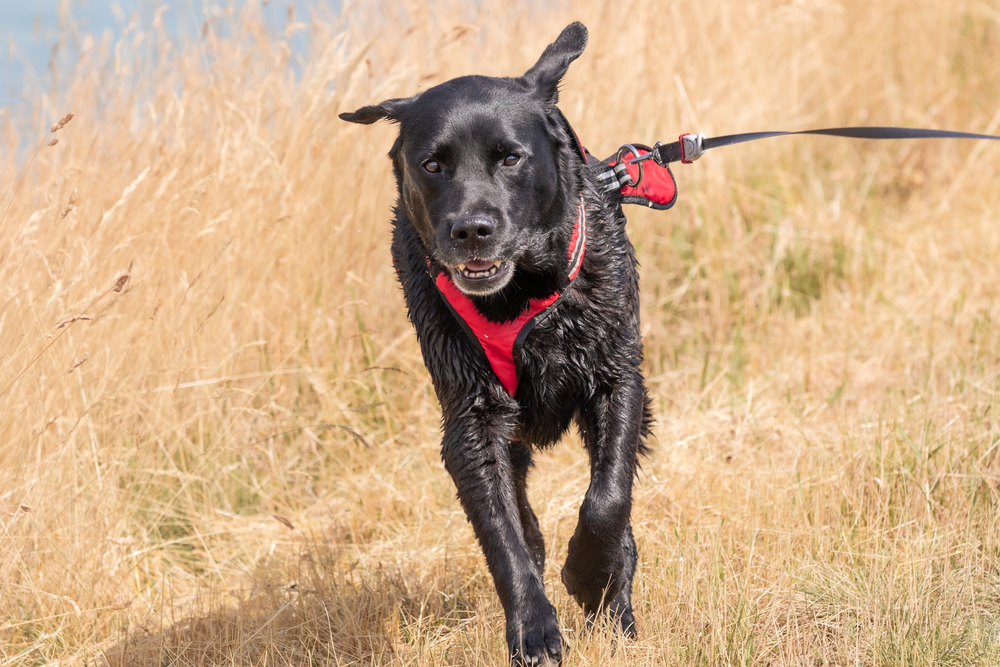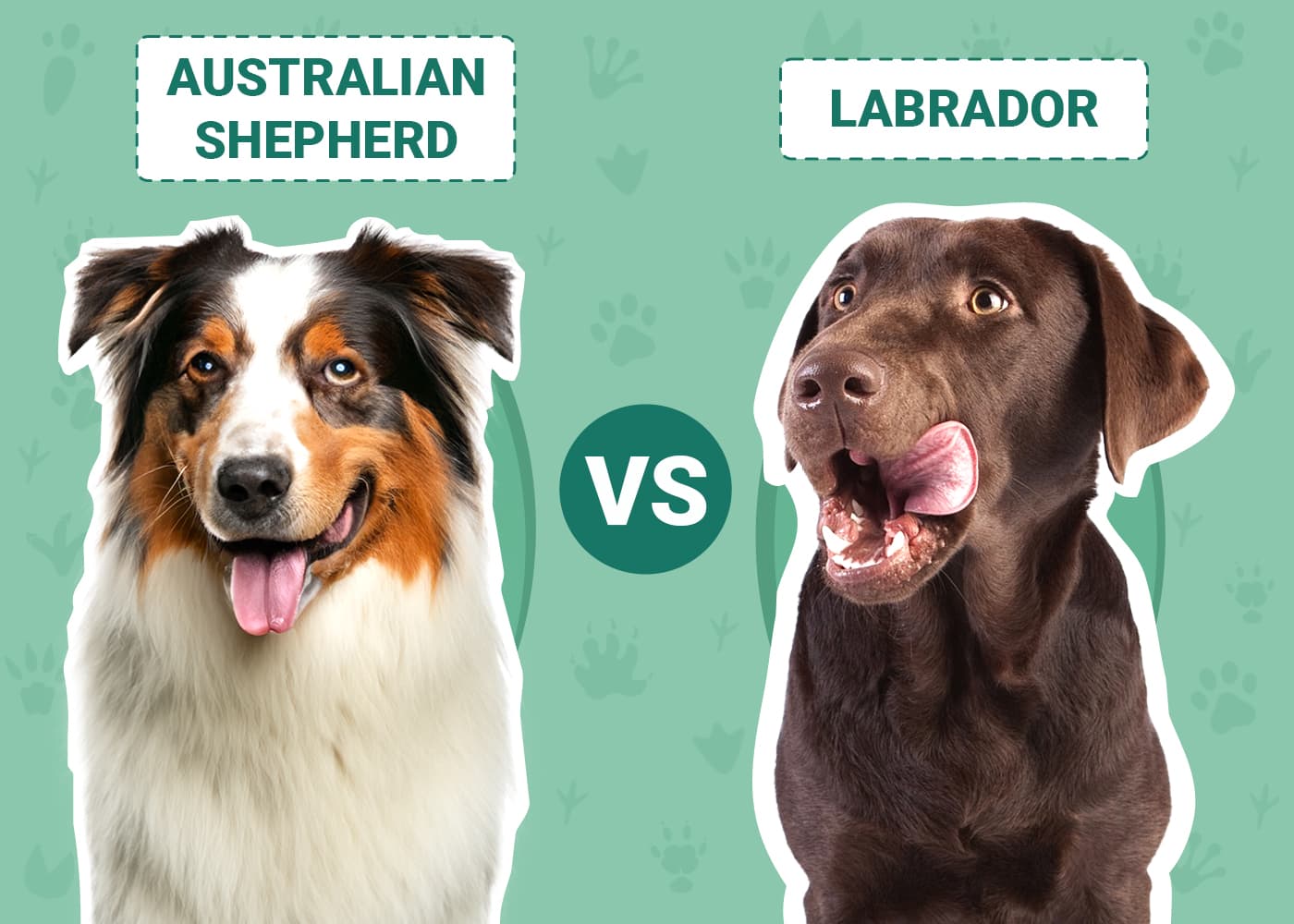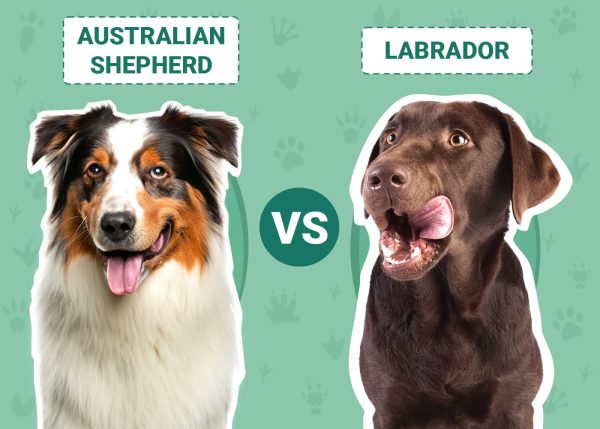Click to Skip Ahead
The Australian Shepherd and Labrador Retriever are polar opposites in terms of lifestyle, but they’re both large and in charge, active, and above all loving. The Australian Shepherd breed originated in California and was bred to be sheepdogs, as their name suggests. Sleek, athletic, and intelligent, this breed is perfect for a busy, active household.
The Labrador retriever is America’s most popular dog, and for good reason. Hailing from the United Kingdom and first bred for fishing, the ancestors of this breed can be traced back to the 1880s. Two dogs imported from Newfoundland mated with two females, and the offspring was the birth of the breed. All modern Labradors can be traced back to this one litter.
Visual Differences

At a Glance
- Average height (adult): 18–23 inches
- Average weight (adult): 40–65 pounds
- Lifespan: 12–15 years
- Exercise: 2+ hours a day
- Grooming needs: Moderate
- Family-friendly: Yes
- Other pet-friendly: Sometimes
- Trainability: Intelligent, loyal, eager to please, wants to herd everything and anything (kids, other pets, etc.)
- Average height (adult): 5–24.5 inches
- Average weight (adult): 55–80 pounds
- Lifespan: 10–13 years
- Exercise: 1+ hours a day
- Grooming needs: Moderate
- Family-friendly: Yes
- Other pet-friendly: Yes
- Trainability: Intelligent, eager to please, food motivated
Australian Shepherd Overview
Australian Shepherds are hard-working dogs who were bred for a purpose. While similar to other breeds in specific ways (such as having the work drive of a Collie and herding drive of a Sheepdog), the Australian Shepherd is in a class of its own.

Personality
The Australian Shepherd is bright, warm, and always eager to please. Some of them are always on the go, and some have an off switch, but most Australian Shepherds need long-term mental stimulation to help keep them happy and satisfied.
They are very bright and adaptive; the modern Australian Shepherd is perfectly suited to being a pet and will playfully interact with the whole family. However, the herding instinct in the breed is still strong; it’s not uncommon for Australian Shepherds to try and herd pets, children, and even older family members!
Training
Training the Australian Shepherd can be a very rewarding experience for those with the mindset and the willingness to go at the Shepherd’s pace. Australian Shepherds can perform actions with lightning speed and perfect accuracy.
They are incredibly intelligent and fun to train, particularly if you find out their motivations, such as food, affection, or toys. The Australian Shepherd is adaptable and can learn every trick in the book.
Health
Australian Shepherds do have some potential health issues, which are passed down through their genes. Of particular note is the gene that causes some Shepherds (not all) to be allergic to ivermectin, the ingredient found in most effective external parasite treatments.
Not all dogs will be affected by this, but a specific subset of breeds (including Australian Shepherds and Collies) can have a severe adverse reaction to this medication, so if in doubt, always ask your vet.
The black and white Australian Shepherd can sometimes be subject to partial or complete deafness as well as having problems with their eyesight if they carry the merle gene.
A dog that expresses the merle gene will more than likely have at least one of these issues, as the genes expressed in black and white Australian Shepherd that allow them to be merle also activate and cause problems with eyesight and deafness. While a deaf or partially sighted dog will be an absolute joy for anyone who owns him, preparing for any dog that requires additional needs is sensible.
Like other large dogs, the Australian Shepherd can suffer from hip dysplasia or patellar luxation. However, puppies from reputable breeders should be checked for the disease, and the parents should show no signs of hip dysplasia or patellar luxation.

Activity Level
Australian Shepherds are highly active dogs, and they need a family that enjoys long walks and games. The dogs were bred around the rodeo, and they have boundless energy and must channel it; otherwise, their behavior can become destructive.
Aussies can quickly get bored, and they need to have long walks every day, commonly up to 2 to 3 hours of activity; this is where games like fetch and frisbee can help stretch their legs and help keep them feeling relaxed and happy. Like any older dog, Australian Shepherds will usually slow down as they age.
However, they still retain their herding instinct and often have a distinctive gait when they have a herding mindset: head forward and low, nose constantly twitching. Your Australian Shepherd will be extremely happy to go on long walks with the whole family. Just don’t be surprised if they try to herd your kids!
Suitable for:
Australian Shepherds are ideally suited to active households who like to get out in the open air. Families with children are ideal, but as with any dog, your Australian Shepherd must be well trained, and your children must know how to respect the dog.
Australian Shepherds can become protective over their family, but they are fun-loving, playful, and always up for a long walk or run in the woods. If you can provide them with the attention they need, they make excellent family pets, which is why they are one of the most popular dog breeds in America today.
Labrador Retriever Overview
The Labrador Retriever is an absolute gem, renowned for being friendly, loyal, and playful at heart. Your Labrador will happily walk by your side doing any task, and some even stick to you like Velcro. Not that you mind, as these happy-go-lucky dogs have sunny dispositions and are an absolute joy to be around.
While they may seem silly and sometimes on the lazy side, they have bursts of energy and are rather intelligent dogs, which makes training them easy.

Personality
The Labrador Retriever is one word in a nutshell: friendly. With their large heads, big paws, and constantly wagging, the Labrador is forever trying to please their owners and families and is always trying to keep everyone smiling.
If you have food around, be ready to see extreme feats of begging since most Labradors are very food motivated, but this is an excellent tool to use in training, as Labradors always want to please.
Labs are warm, comforting, and incredibly loyal dogs. They are also rather steadfast and don’t often get skittish, but because of their retrieving nature, they can sometimes feel the urge to go off and do just that: retrieve.
Exercise
Labradors need around an hour to an hour and a half of exercise time each day. It can be on long walks where you both enjoy throwing a toy during fetch or just rambling and talking to each other; some Labradors are known to be quite talkative and will huff and bark right back at you. Since they are larger dogs, swimming is an excellent activity since it helps to support their weight in the water while being a fun activity to keep fit. They were initially bred for swimming to help with waterfowl retrieving, and most of them love the water. Their double coat is hand because it keeps them dry and warm when swimming in cold water. Some Labradors can be more laid-back, and some are prone to lying down quite often, and taking them out and making a long walk a part of your routine will help to keep them fit and healthy.

Training
Labrador Retrievers are intelligent animals, and as stated before, they are very receptive to their motivators. Most of the time, you’ll find your Labrador is motivated by food, and their favorite treat can help with your training efforts, not that it takes a long time to train most of them anyway.
Because of their intelligence, Labradors will thrive when taught new tricks and tend to retain information and understand commands easily. However, because they have this intelligence, they need mental stimulation daily. If not, they have been known to display destructive behaviors.
Health
Because the lovely Labrador is food orientated, they are prone to obesity which causes a whole host of health problems. They’re large dogs as well, which means they also suffer from potential hip dysplasia and patellar luxation, as well as cruciate ligament injuries when they go barreling down hills and jumping into ponds.
However, as with any puppy, the sire and dam should be tested for any genetic problems before being bred. If you’re concerned, talk to a reputable breeder about the tests they run on their dogs before breeding. The Labrador otherwise is very hardy, but only a few problems are more likely for Labradors than other breeds of dog. One of these is a lipoma, a benign fatty lump found under the skin.

Activity Level
Labrador Retrievers need an hour to an hour and a half of activity each day to keep them happy and engaged and to burn off enough energy. Because of their intelligence, they can easily get bored, which is why owners need to ensure that the active dogs are thoroughly engaged during the day and have enjoyed their time outside.
They wouldn’t make good apartment dogs for this reason because they need the space to roam. They’re not always on the go like Australian Shepherds, but they still need outdoor time and enough space to stretch their legs.
Suitable for:
The Labrador is suitable for any family who wants a loving, loyal, and devoted dog. Families with young children will delight in the friendly-faced Lab, but as with any dog, leaving young children unsupervised with them is never a good idea.
Even the sweetest, most gentle canine can only understand so much, so it is sensible to supervise them at all times, even though your Labrador is much more likely to give them a big kiss on the face than anything else. Because they are large dogs, they can cause accidental problems with tiny children.
Generally, labradors are the happiest, most calm, contented, and loving family dogs anyone could ask for, which is why they’re the most popular dog breed in America. The Labrador doesn’t need as much time spent with them as the Australian Shepherd does, and those who go out to work can keep a Labrador Retriever happy with toys at home. But ultimately, ensuring they have all the love and attention they need is the best thing for them.
Which Breed Is Right For You?
The Australian Shepherd and Labrador Retriever are two very different dogs that share some traits. Both are family dogs. One is ideal for the active, outdoors family who has plenty of time to adventure (Aussie Shepherd), while the other prefers normal walking, a good game of frisbee, and relaxing by the fire (Labrador).
Both the Australian Shepherd and Labrador are good with kids, and the Labrador does slightly better with other animals. However, this greatly depends on each dog and how they were socialized as puppies. In general, your choice and suitability for either breed depend on how much time you have to spend on your dog each day, as the Australian Shepherd requires more time exercising than the Labrador Retriever.












